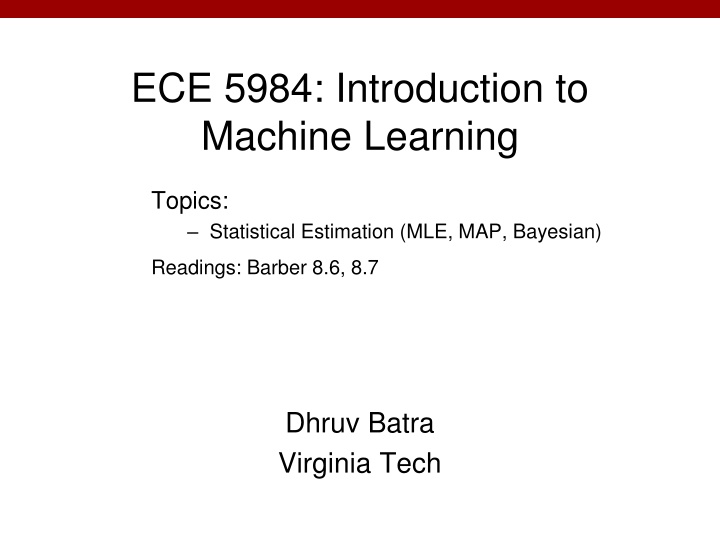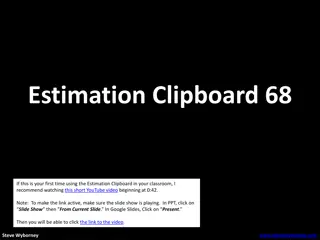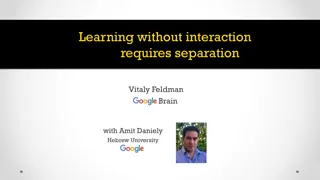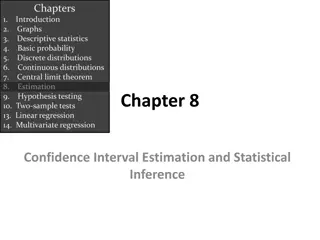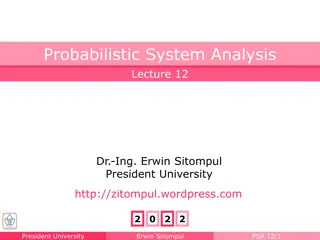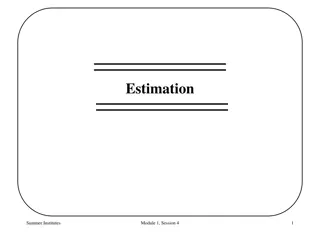Introduction to Statistical Estimation in Machine Learning
Explore the fundamental concepts of statistical estimation in machine learning, including Maximum Likelihood Estimation (MLE), Maximum A Posteriori (MAP), and Bayesian estimation. Learn about key topics such as probabilities, interpreting probabilities from different perspectives, marginal distributions, conditional distributions, likelihood, prior, posterior, and KL-Divergence. Dive into the applications of these concepts in training and testing stages of machine learning models.
Download Presentation

Please find below an Image/Link to download the presentation.
The content on the website is provided AS IS for your information and personal use only. It may not be sold, licensed, or shared on other websites without obtaining consent from the author.If you encounter any issues during the download, it is possible that the publisher has removed the file from their server.
You are allowed to download the files provided on this website for personal or commercial use, subject to the condition that they are used lawfully. All files are the property of their respective owners.
The content on the website is provided AS IS for your information and personal use only. It may not be sold, licensed, or shared on other websites without obtaining consent from the author.
E N D
Presentation Transcript
ECE 5984: Introduction to Machine Learning Topics: Statistical Estimation (MLE, MAP, Bayesian) Readings: Barber 8.6, 8.7 Dhruv Batra Virginia Tech
Administrativia HW0 Solutions available HW1 Due on Sun 02/15, 11:55pm http://inclass.kaggle.com/c/VT-ECE-Machine-Learning-HW1 Project Proposal Due: Tue 02/24, 11:55 pm <=2pages, NIPS format (C) Dhruv Batra 2
Recap from last time (C) Dhruv Batra 3
Procedural View Training Stage: Raw Data x Training Data { (x,y) } f (Feature Extraction) (Learning) Testing Stage Raw Data x Test Data x f(x) (Apply function, Evaluate error) (Feature Extraction) (C) Dhruv Batra 4
Statistical Estimation View Probabilities to rescue: x and y are randomvariables D = (x1,y1), (x2,y2), , (xN,yN) ~ P(X,Y) IID: Independent Identically Distributed Both training & testing data sampled IID from P(X,Y) Learn on training set Have some hope of generalizing to test set (C) Dhruv Batra 5
Interpreting Probabilities What does P(A) mean? Frequentist View limit N #(A is true)/N limiting frequency of a repeating non-deterministic event Bayesian View P(A) is your belief about A Market Design View P(A) tells you how much you would bet (C) Dhruv Batra 6
Concepts Marginal distributions / Marginalization Conditional distribution / Chain Rule Bayes Rule (C) Dhruv Batra 7
Concepts Likelihood How much does a certain hypothesis explain the data? Prior What do you believe before seeing any data? Posterior What do we believe after seeing the data? (C) Dhruv Batra 8
KL-Divergence / Relative Entropy (C) Dhruv Batra Slide Credit: Sam Roweis 9
Plan for Today Statistical Learning Frequentist Tool Maximum Likelihood Bayesian Tools Maximum A Posteriori Bayesian Estimation Simple examples (like coin toss) But SAME concepts will apply to sophisticated problems. (C) Dhruv Batra 10
Your first probabilistic learning algorithm After taking this ML class, you drop out of VT and join an illegal betting company. Your new boss asks you: If Novak Djokovic & Rafael Nadal play tomorrow, will Nadal win or lose W/L? You say: what happened in the past? W, L, L, W, W You say: P(Nadal Wins) = Why? (C) Dhruv Batra 11
(C) Dhruv Batra 12 Slide Credit: Yaser Abu-Mostapha
Maximum Likelihood Estimation Goal: Find a good What s a good ? One that makes it likely for us to have seen this data Quality of = Likelihood( ; D) = P(data | ) (C) Dhruv Batra 13
Sufficient Statistic D1 = {1,1,1,0,0,0} D2 = {1,0,1,0,1,0} A function of the data (Y) is a sufficient statistic, if the following is true i D2 f(yi) = f(yi) L(q;D1)= L(q;D2) i D1 (C) Dhruv Batra 14
Why Max-Likelihood? Leads to natural estimators MLE is OPT if model-class is correct Log-likelihood is same as cross-entropy Relate cross-entropy to KL (C) Dhruv Batra 15
How many flips do I need? Boss says: Last year: 3 heads/wins-for-Nadal 2 tails/losses-for-Nadal. You say: = 3/5, I can prove it! He says: What if 30 heads/wins-for-Nadal 20 tails/losses-for-Nadal. You say: Same answer, I can prove it! He says: What s better? You say: Humm The more the merrier??? He says: Is this why I am paying you the big bucks??? 16 Joke Credit: Carlos Guestrin
Bayesian Estimation Boss says: What is I know Nadal is a better player on clay courts? You say: Bayesian it is then.. (C) Dhruv Batra 17
Priors What are priors? Express beliefs before experiments are conducted Computational ease: lead to good posteriors Help deal with unseen data Regularizers: More about this in later lectures Conjugate Priors Prior is conjugate to likelihood if it leads to itself as posterior Closed form representation of posterior (C) Dhruv Batra 18
Beta prior distribution P() Demo: http://demonstrations.wolfram.com/BetaDistribution/ 19 Slide Credit: Carlos Guestrin
Benefits of conjugate priors (C) Dhruv Batra 20
MAP for Beta distribution MAP: use most likely parameter: Beta prior equivalent to extra W/L matches As N inf, prior is forgotten But, for small sample size, prior is important! 21 Slide Credit: Carlos Guestrin
Effect of Prior Prior = Beta(2,2) prior = 0.5 Dataset = {H} L( ) = MLE = 1 Posterior = Beta(3,2) MAP = (3-1)/(3+2-2) = 2/3 (C) Dhruv Batra 22
What you need to know Statistical Learning: Maximum likelihood Why MLE? Sufficient statistics Maximum a posterori Bayesian estimation (return an entire distribution) Priors, posteriors, conjugate priors Beta distribution (conjugate of bernoulli) 23
